IN THIS SITE...
Health and seasons
Seasonal patterns for health conditions generate regular attention from both the media and the public. Several health conditions such as asthma and flu may traditionally be regarded as seasonal conditions. Furthermore, figures show that other diagnoses such as depression, heat/sun stroke and the norovirus occur mainly in seasonal blocks as well.
This article identifies trends and patterns (during each calendar month) in which emergency admissions1 take place due to primary diagnoses of; asthma2, sunstroke and heatstroke3, depression4 or pneumonia5. The period under review is 2005-06 to 2009-10.
What does HES tell us about seasonal health?
Hospital Episodes Statistics (HES) contains roughly 16 million inpatient records for each data year (1 April to 31 March). Each record contains information for a range of fields, such as the patient's age, sex, the diagnoses they were admitted with and how they were admitted to hospital (self admittance or via GP referral, for example). This paper provides details of the number of finished admission episodes6, per month, for four specific diagnoses, showing possible trends throughout the year.
The HES data used in this paper looks at diagnoses in the primary diagnosis position (unless stated otherwise in the footnotes) and admissions to hospital due to an emergency only (see footnotes for details).
Asthma
Figure 1, below, shows the number of emergency admissions recorded in HES where the primary diagnosis was asthma. During the period under review (2005-06 to 2009-10), total recorded asthma cases have fallen by approximately 2 per cent while the fall between 2008-09 and 2009-10 is approximately 7 per cent. By contrast the number of emergency admissions during the critical months of September to December has been increasing at a much faster rate. Thus, for example, the number of admissions during these months for the period 2005-06 to 2009-10 has risen by approximately 9 per cent.
There are many things that can trigger asthma symptoms. One of the more common is the hay fever season, which can start as early as February and continue until late May.
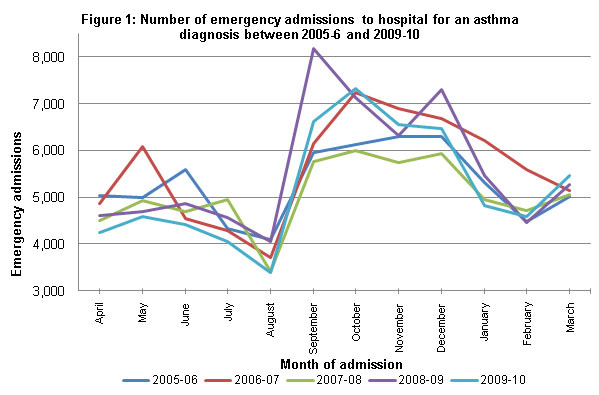 |
HES data also reveals that the number of emergency admissions in September to December were generally above the annual average during the period under review. By contrast, August appears to consistently have the lowest number of emergency admissions. A possible cause for the sharp rise after the summer could be a variety of reasons, including low level pollution due to warm weather and generally sticky, humid conditions that can make it harder for asthma sufferers to breathe.
Sun/heat stroke
Figure 2, below, shows the number of admissions to hospital in which the patient had a diagnosis of a sun/heat stroke with an emergency admittance.
HES data reveals that there was a sharp rise in the number of emergency admissions to hospital with sun/heat stroke in 2006-07 compared to 2005-06 (93 emergency admissions compared to 60). The number of admissions was lower in subsequent years (30 in 2007-08, 31 in 2008-09 and 50 in 2009-10).
As we might expect, the data shows a high number of admissions in the summer months. According to the Met Office, summer 2006 was exceptionally warm, dry and sunny, with a temperature of 36.5C recorded in July, which is the highest temperature recorded since 1911. This may partly explains the sharp increase in hospital admissions for sun/heat stroke 2006-07.
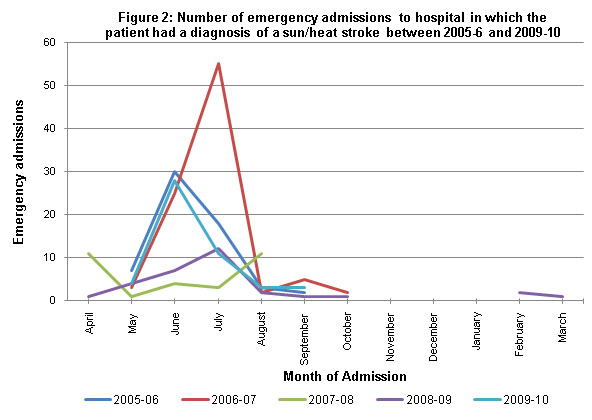 |
Depression
Depression is very common. In fact, it affects between five and ten percent of the population at any one time. However, the diagnosis of depression causes much confusion as doctors refer to depression when someone is feeling in a 'low mood' and also when referring to a 'depressive illness' or 'episode'. In a typical depressive episode the patient suffers from lowering of mood, reduction of energy and a decrease in activity. The lowered mood varies little from day to day, is unresponsive to circumstances and may be accompanied by so called 'somatic' symptoms, such as loss of interest and pleasurable feelings. There is often speculation that seasonal changes affect depression. Figure 3, below, shows the number of emergency admissions to hospital where the primary diagnosis is depression.
It appears that more admissions are recorded during spring, with peaks around April/May. The figures then tend to gradually decline up to December. The trends appear to contradict the widely held view that the Christmas period is the worst time for those who suffer from depression, although it should be noted that HES data only includes information about individuals treated in hospitals - not those treated in a primary care setting or indeed those individuals who don't seek medical help or advice when depressed.
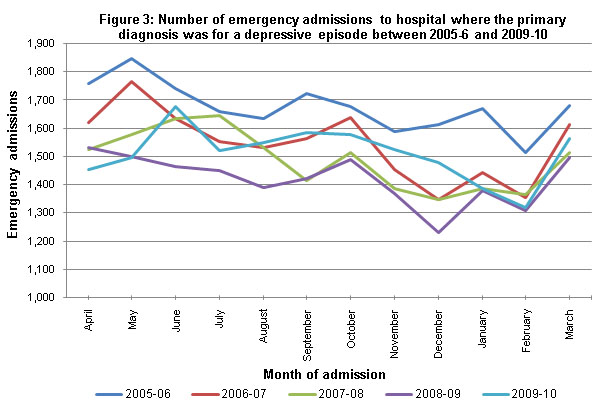 |
Pneumonia
Influenza (more commonly known as the flu) is an infection of the respiratory tract caused by a flu virus. There are various symptoms including sneezing and coughing. Sometimes, most commonly in elderly people, a chest infection can develop which occasionally, in extreme circumstances, can develop into pneumonia. Pneumonia is an inflammation in the lungs, where the alveoli fill up with fluid making it harder to breathe. It can be treated by a course of antibiotics but in certain circumstances can be life threatening. Figure 4 shows the number of admissions to hospital where the diagnosis is pneumonia.
We can see that the admissions are highest through the colder months of the year and lowest in the summer. For example, about 42 per cent of the total emergency admissions for pneumonia related diagnoses were in and between November and February, in each of the years 2005-06 to 2009-10. There are several health conditions that increase the risks of pneumonia. One condition is a lowered immune system, which can occur after having the influenza virus (mentioned above). As flu generally occurs around the autumn/winter months, this is a possible reason for the higher numbers between November and February.
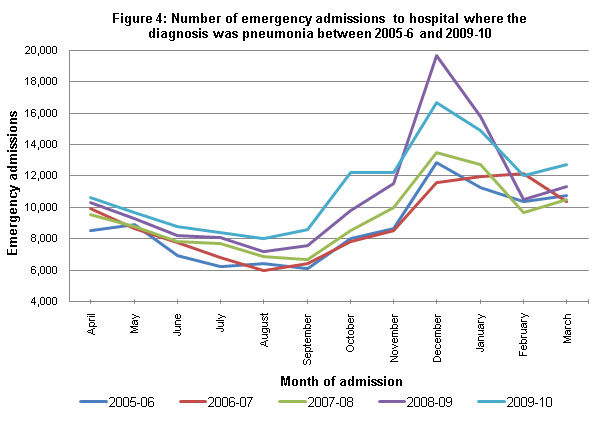 |
It is also noted from HES data that 2009-10 had much higher emergency admissions compared to all the other years. Over the period 2005-06 to 2009-10 the total number of emergency admissions for pneumonia increased by approximately 28 per cent.
Further information
Table 1 below shows the annual totals for the data in figures 1 to 4 above.
| Table 1: Total emergency admissions | ||||
|---|---|---|---|---|
| Years | Total emergency admissions | |||
| Asthma | Depression | Pneumonia | Sun/heat stroke | |
| 2005-06 | 63,570 | 20,105 | 105,107 | 60 |
| 2006-07 | 67,387 | 17,027 | 108,031 | 93 |
| 2007-08 | 60,640 | 18,519 | 112,306 | 30 |
| 2008-09 | 66,864 | 17,845 | 129,122 | 31 |
| 2009-10 | 62,498 | 18,130 | 134,892 | 50 |
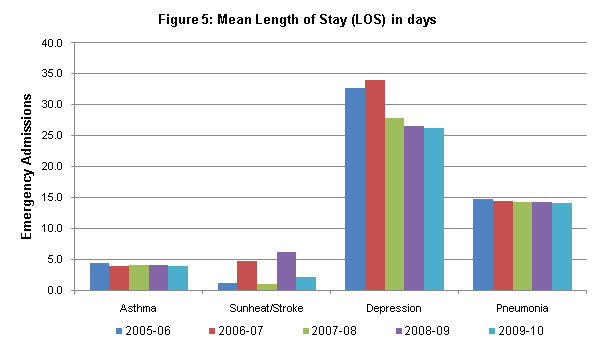 |
Figure 5 above shows the Mean Length of Stay (LOS) in Days, highlighting that depression accounts for the highest number of length of stay sunheat/sunburn accounts for the lowest number of length of stays.
Footnotes
1. Emergency admission only
- 21 - via A&E;
- 22 - via GP
- 23 - via Bed Bureau, including the Central Bureau
- 24 - via consultant out-patient clinic
- 28 - other means, including patients who arrive via the A&E; department of another health care provider).
2. Asthma diagnoses
Primary diagnoses:
- J45 - Asthma
- J46 - Status Asthmaticus
3. Sun/heat stroke diagnoses
Primary diagnoses:
- T67 - Effects of heat and light
4. Depression diagnoses
Primary diagnosis:
- F06.3 Organic mood [affective] disorder
- F20.4 Post-schizophrenic depression
- F32 Depressive Episode
- F33 Recurrent Depressive Disorder
- F34.1 Dysthymia
- F41.2 Mixed anxiety and depressive disorder
- F44.8 Other dissociative [conversion] disorders
- F53.0 Mild mental and behavioural disorders associated with the puerperium, not elsewhere classified
- F92.0 Depressive conduct disorder
5. Pneumonia diagnoses
Primary diagnoses:
- B20.6 - HIV disease resulting in pneumocystis carinii pneumonia
- J10.0 - Influenza with pneumonia, influenza virus identified
- J11.0 - Influenza with pneumonia, virus not identified
- J12 - Viral pneumonia, not elsewhere classified
- J13.X - Pneumonia due to Streptococcus pneumoniae
- J14.X - Pneumonia due to Haemophilus influenzae
- J15 - Bacterial pneumonia, not elsewhere classified
- J16 - Pneumonia due to other infectious organisms, not elsewhere classified
- J18 - Pneumonia, organism unspecified
- J85.1 - Abscess of lung with pneumonia
- P23 - Congenital pneumonia
Secondary diagnosis:
- J17 - Pneumonia in diseases classified elsewhere
6. Finished admission episodes
A finished admission episode is the first period of inpatient care under one consultant within one healthcare provider. Finished admission episodes are counted against the year in which the admission episode finishes. Please note that admissions do not represent the number of inpatients, as a person may have more than one admission within the year.
Assessing growth through time
HES figures are available from 1989-90 onwards. During the years that these records have been collected by the NHS there have been ongoing improvements in quality and coverage. These improvements in information submitted by the NHS have been particularly marked in the earlier years and need to be borne in mind when analysing time series data.
Changes in NHS practice also need to be borne in mind when analysing time series data. For example, some procedures may now be undertaken in outpatient settings and may no longer be accounted for in HES inpatient data. This may explain any reductions in activity over time.


